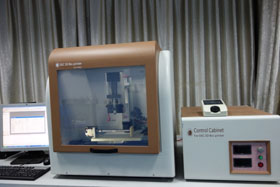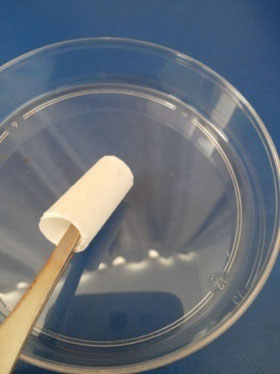Researchers working at Shanghai University’s Rapid Manufacturing Engineering Center in China have developed what is believed to be the world’s first tri-layer vascular graft. By designing a three layer composite and employing a combination of micro-imprinting and electro-spinning techniques, the scientists have been able to engineer separate composite materials able to respectively provide both mechanical strength and new cell growth promotion — deficiencies of which have been a significant shortcoming with existing vascular graft procedures using only single or double layer materials.

Vascular grafts (AKA vascular bypass) surgical procedures are for the purpose of rerouting to redirect blood flow in a region of the body. The operation is typically performed in order to address inadequate blood flow (ischemia) or as part of organ transplantation procedures. The vascular bypass is surgically grafted onto an obstructed or otherwise unhealthy blood vessel to permanently redirect blood flow, for example in coronary bypass surgery. Ideally, vein material harvested from the patient him or herself, or, failing that, a donor’s vein (allograft) is the preferable material for use in vascular grafts, but because these sources are often insufficient to supply a patient’s needs — possibly due to the underlying conditions that necessitate the graft in the first place — synthetic materials such as ePTFE or dacron are also commonly used.
Consequently, there has been a strong research focus on development of synthetic vessel materials that more closely mimic natural ones, for example by letting new cells to grow around them — then degrade away, in the process creating new vessels. Electrospinning, a process which uses an electrical charge to draw liquid inputs — in this instance a composite of chitosan and polyvinyl alcohol — into incredibly fine fibers, also allows for a high surface-to-volume ratio of nano fibers, providing ample space for host cells to grow and connect. These components all naturally degrade within six months to a year, leaving behind a new, intact blood vessel. The composite forming process also makes controlling degradation of the composite vascular graft easier.
However, these electrospun structures are not very rigid, so incorporating a microimprinted middle layer of poly-p-dioxanone, a biodegradable polymer commonly used in biomedical applications addresses the robustness issue.
The researchers report that the middle layer of their tri-layer synthetic graft is fabricated by micro-imprinting poly-p-dioxanone (PPDO), while the inner and outer layers are formed from electrospun chitosan and polyvinyl alcohol (PVA). The graft morphology is characterized with scanning electron microscopy. The materials’ respective qualities make the tri-layer graft greater than the sum of its component elements. PPDO increases mechanical strength and helps ensure constant graft thicknesses. The scientists explain that cells cultivated on the vascular grafts adhere and proliferate better because of the natural, biological chitosan in the inner and outer layers.

“The composite vascular grafts could be better candidates for blood vessel repair,” Rapid Manufacturing Engineering Center associate professor Yuanyuan Liu commented in an AIP Advances report by John Arnst, who notes that Dr. Liu’s team had previously researched and developed bone scaffolds used to repair bone defects, before refocusing on cardiovascular disease, and specifically vascular grafts.
The scientists describe their current research in the online-only, Open Source, peer-reviewed journal AIP Advances, in an article entitled “Composite vascular repair grafts via micro-imprinting and electrospinning“ (AIP Advances 5, 041318 (2015); http://dx.doi.org/10.1063/1.4906571), coauthored by Yuanyuan Liu, Ke Xiang, Qingxi Hu, and Haiping Chen of the Rapid Manufacturing Engineering Center at Shanghai University. Yuanyuan Liu and Qingxi Hu are also affiliated with the Shanghai Key Laboratory of Intelligent Manufacturing and Robotics in Shanghai.
The researchers note that composite vascular grafts formed by micro-imprinting and electrospinning have been shown to have improved mechanical properties, and biocompatibility compared with graft material formed by electrospinning alone. They explain that tree-layered composite grafts more closely mimic the three-layered structure of natural blood vessels while avoiding defects that result from single processes.
Because cardiovascular disease is a leading cause of death worldwide, there is great interest in finding a source of engineered vascular grafting to be used as a surgical solution, providing an alternative source of vascular replacement materials for patients, thereby circumventing shortages of autologous cells and avoiding the use of diseased vessels for vascular bypass.
The Liu lab researchers explain that in order to better encourage cell engraftment and proliferation, surrogate scaffolds must be bioengineered to possess the native histo-architecture of the damaged vessel to the greatest degree possible. They note that the principle challenge in synthetic tissue engineering is to fabricate customizable and biodegradable scaffolds that mimic the components and structural aspects of native extracellular matrices, and that therefore “Composite vascular repair grafts via micro-imprinting and electrospinning” have important applications in biomedicine, offering unique advantages in vascular graft preparation, for example a high surface-area-to-volume ratio of nanofibers and biomimicry of the extracellular matrix structure and functions.
However, the scientists point out the structure of these vascular grafts is not maintained because of poor mechanical properties, and their non-woven fabrics pattern, and that ideally, vascular grafts should offer robust biocompatibility and mechanical properties, combining natural materials blended with synthetic polymers. However, despite attempts with various blending systems utilizing a variety of different process parameters and post-processing treatments, mechanical properties of electrospun fibrillar matrices remains poor.
Thus, the Liu research group has addressed the issue of mechanical strength by forming composites in the vascular scaffold with their three-layered composite graft design, whose mechanical properties are better than those of grafts prepared through electrospinning alone. They note that cell proliferation rates on the chitosanPVA fibers were higher when the cells did not contact the PPDO polymers, and that their results indicate that composite vascular grafts made of chitosan-PVA and PPDO might be suitable candidates for vascular repair applications.
While much work remains to be done before the prospect of human trials, Dr. Liu and her group are optimistic about the future of their research, with their next project being to test the implants in an animal model, to observe the structures efficacy with live vascular cells.
Sources
AIP Advances
Shanghai University
Wikipedia
Image Credits:
Yuanyuan Liu/Shanghai University

